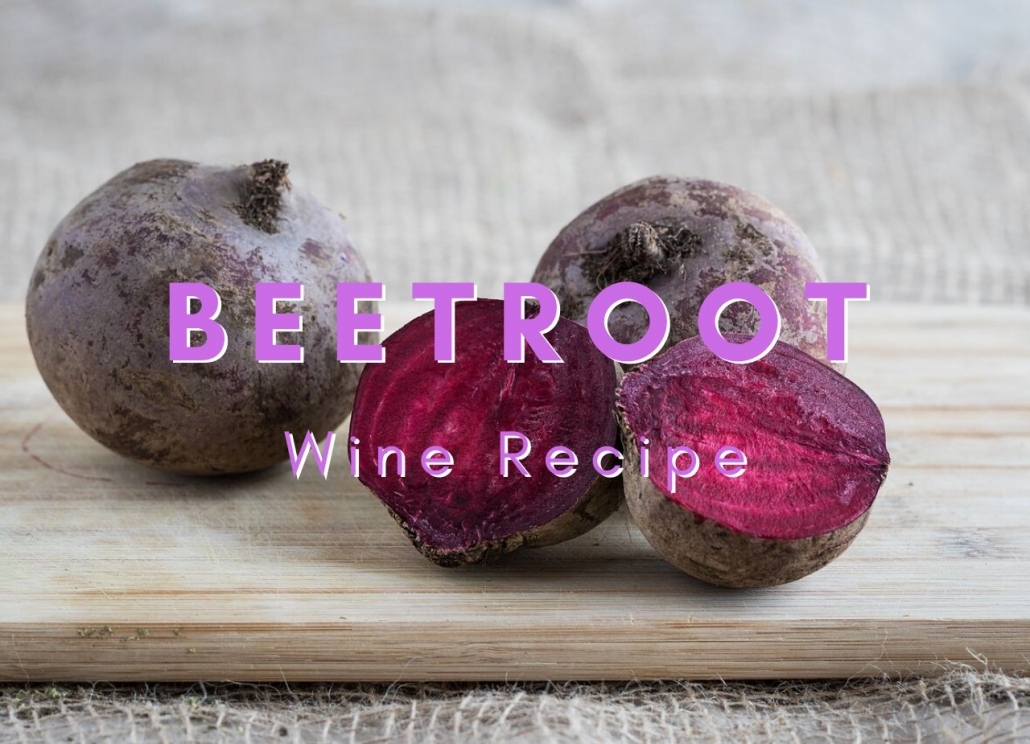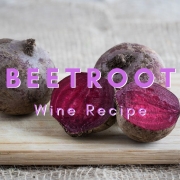Beetroot Wine Recipe

Beetroot wine is not as peculiar as it may sound. I think a lot of vegetable wines have a bad reputation that isn’t wholly deserved.
Beetroot wine doesn’t evoke the same fruity, delicious thoughts as perhaps a blackberry wine but vegetables like beetroot do in fact make great wines.
Table of Contents
A Wine For The Season
Beetroots are in season throughout summer until early winter and store well for months unlike soft fruits.
This means there is a plentiful supply when fruits for winemaking have been and gone.
The other thing about starchy root vegetables like beetroot is they do contain sugars, complex flavour compounds and in the case of beetroot a massive amount of colour.
Burgundy-Like Beetroot Wine
Everybody knows that red beetroot will stain anything it touches. That colour transfers quite spectacularly into wine, the resulting wine is a deep, rich red that plays a big part in the way you perceive it when you taste it.
Beetroot has a great earthy quality that does come through into the wine, if you aren’t a fan of the flavour of beetroot then I would give it a miss, if like me, you like beetroot then this is well worth trying.
Spice It Up
Vegetable wines like this, that use starchy root vegetables can make great backgrounds for introducing some bolder flavours. It can be desirable, even with fruit wines to introduce some complementary flavours that make a wine more robust and unique.
Beetroot pairs well with a lot of spices because it has a rounded, earthy flavour. A small amount of cinnamon or nutmeg along with the beetroot makes a great winter warming wine.
Alternatively, coriander and orange zest, much like in a weisse beer can really work well with that earthy tone.
Which Beetroot For Your Wine?
If you grow your own or lucky enough to have a good market or grocers you can find a whole variety of colours of beetroot. The difference in flavour is not that noticeable but you can make a nice golden wine with the paler orange coloured beetroots.
Smaller Means Sweeter
The larger the beetroot the more woody it tends to get. Smaller beetroot tend to have a sweeter flavour and I think this is going to make a difference in the finished wine. I choose to use smaller beetroot but I am happy to be proven wrong.
Build Body WIth Raisins
A lot of country wines include raisins because they provide body and mouthfeel. What the beetroot lacks in body can be boosted by adding a small amount of raisins.
The flavour raisins provide won’t mask the beetroot and the wine wine will be enhanced by the added body.
What You’ll Need To Make Beetroot Wine – Makes 1 gallon / 4.5 litres
- Large Stock Pot
- Small Fermenting Bucket
- Demijohn
- Syphon
- Fine Straining Bag
- Airlock & Bung
Beetroot Wine Ingredients
- 1.5 kg Beetroot (trimmed, washed and green parts removed)
- 4 litres Water
- 1.2 kg Sugar
- 120g Raisins (roughly chopped)
- 1/4 tsp Wine Tannin
- 1 tsp Pectic Enzyme
- 1 tsp Yeast Nutrient
- 1 Campden Tablet
- 1 Sachet Yeast
Take the washed beetroots with any green stems removed, the skins can be left on. Cut into quarters and add them to a pan with just enough water to cover them, turn on the heat and bring to a simmer. Cook until just tender around 30 – 45 minutes.
Using a slotted spoon remove the beetroot from the pan leaving the water behind. Save a handful of beetroot but the rest can be used, cooked with or thrown away.
Add the sugar to the pan and bring to a simmer to dissolve. Whilst this is happening add the straining bag to the sanitised fermenter and add the roughly chopped raisins, add a handful of reserved beetroot to the bag and secure the top.
Take the beetroot and sugar solution off the heat and pour into the fermenter. Give everything a stir around to combine and then add cold water to bring the volume up to 4.5 litres. Add the tannin, yeast nutrient and crushed Campden tablet and then stir to combine, cover and leave for at least 24 hours.
24 hours later add pectic enzyme and mix thoroughly. Take a hydrometer reading if you wish. The yeast can then be sprinkled onto the surface of the must. The fermenter can be covered and the airlock fitted, fermentation will then start 24 – 72 hours later.
Leave the beetroot wine to ferment for around 7 days before lifting the straining bag and discard the remaining pulp. Cover the fermenter again and leave to ferment for another 2 days. After 2 days transfer the beetroot wine to a sanitised demijohn. Fit a bung and airlock and allow to condition and settle. Take a hydrometer reading to check fermentation if you wish.
Allow the wine to condition in the demijohn for around a month. After a month or so the beetroot wine will have begun to clear. Rack the wine to a clean, sanitised demijohn and allow to bulk age.
Leave the wine to condition and mature in the demijohn for at least 3 months but the longer the better. The beetroot wine will improve with time, bottle after maturing, you can back sweeten the wine at this point if you want. Enjoy up to 1 year or 2 after bottling.




Leave a Reply
Want to join the discussion?Feel free to contribute!